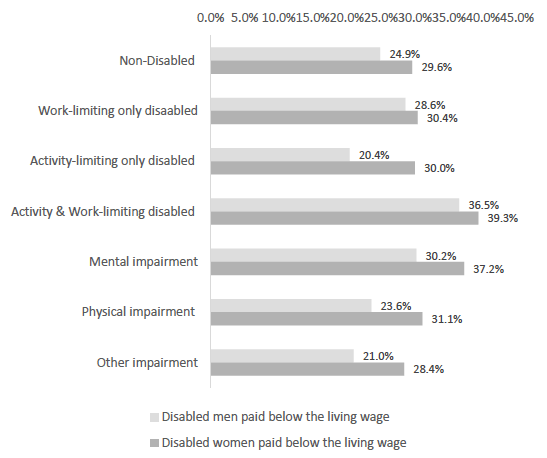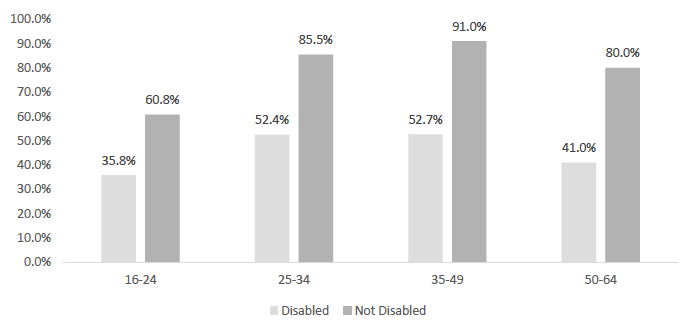Scotland's Wellbeing: national outcomes for disabled people
Analysis of the National Performance Framework (NPF) outcome indicators from the perspective of disability.
8. Fair Work And Business
We have thriving and innovative businesses, with quality jobs and fair work for everyone
What we Know:
- Disabled people are more likely to be economically inactive than non-disabled people. The disability employment gap in Scotland is estimated as 35.5%.
- The disability employment gap was lower for disabled women than for disabled men. It was also lower for young disabled people.
- Compared to non-disabled people, disabled people are more likely to be affected by collective bargaining agreements (40% compared to 36%).
- In the UK as a whole, disabled people are more likely than non-disabled people to be paid less than the living wage.
- In the UK as a whole, research suggests there is a disability pay gap of approximately 15% in favour of non-disabled people.
National outcome
This outcome intends to take seriously the wellbeing and skills of the workforce and provide good quality, fair work, training and employment support for all, ensuring that necessary legislative and operational structures are in place, that employers actively fulfil their corporate responsibilities, that social enterprise is supported and that there is investment in research and development.
National Performance Indicators
The National Performance Framework has nine indicators for Fair Work and Business. Four of these do not measure individual outcomes:
- Economic Participation (Scotland's position on labour market participation as the top performing country in the UK through a comparison of the employment rates in the four constituent countries of the UK. The gap between Scotland’s employment rate and the rate of the top performing country in the UK)
- High Growth Businesses (The percentage of businesses which are high growth enterprises as a share of all registered enterprises).
- Innovative Businesses (Proportion of businesses that were innovation active during the survey period)
- The number of businesses (The total number of private sector enterprises (registered for Value Added Tax and/or Pay As You Earn) in Scotland per 10,000 adults).
Another indicator is in development:
- Contractually Secure Work (No data, indicator currently in development)
A further two are specifically concerned with gender as it relates to work and could be helpful in analysing work for disabled women:
- Gender Pay Gap (The difference between male and female full-time hourly earnings, expressed as a percentage of male full-time hourly earnings)
- Gender Balance in organisations (Gap between male and female employment rate)
The final indicator is not specifically broken down by disability status:
- Employees on the Living Wage (Percentage of workers earning less than the living wage)
The remaining indicator, however, is available in this form:
- Employee Voice (The percentage of employees who agree that they are affected by collective agreement, defined as whether agreement between trade union and employer affect pay and conditions).
National Performance Indicators
Employee Voice
A higher proportion of disabled people are covered by collective bargaining agreements, when compared to non-disabled people. In 2018, 40% of disabled people in Scotland reported that their pay and conditions are affected by agreements between trade unions and their employer, compared with 36% of non-disabled people.[37]
Additional Indicators
Employees on the Living Wage
The NPF does not provide this figure broken down by disability status. However, the Equality and Human Rights Commission (EHRC) provides UK-level data on disabled people paid below the living wage.[38]
In should be noted than the EHRC uses Labour Force Survey (LFS) data up to 2014. By comparison, the NPF indicators on the gender pay gap and employees on a living wage data are typically based on the Annual Survey of Hours and Earnings (ASHE). For this reason, the figures quoted here are not directly comparable with the NPF data. At present, it is not possible to estimate earnings by disability using ASHE.
The LFS data indicates that disabled people are more likely to be paid below the living wage. The EHRC estimates that, in the period they analysed, 30% of disabled men were paid below this rate, as were 35% of disabled women. By comparison, 25% of non-disabled men and 29% of non-disabled women were paid below the living wage in this period. The proportions of workers paid below the living wage is shown in Figure 8.1. Please note that the proportions are not mutually exclusive.
Figure 8.1 Proportions of workers paid below the living wage in 2014, by disability and disability category.

Source: EHRC, based on data from the Labour Force Survey 1997-2014
Disability Employment Gap
Evidence suggests that there is a pronounced disability employment gap. Data from the APS[39] found that, in Scotland in 2018:
- The employment rate for those aged 16-64 who were disabled was 45.6% compared to 81.1% for those who were not disabled.
- The gap between the employment rates for disabled and non-disabled people was 35.5 percentage points.
- The gap between the employment rates for disabled and non-disabled people was lower for women (31.1 percentage points) than men (40.0 percentage points).
- The employment rate gap between the employment rates for disabled and non-disabled people was lower for 16-24 year olds (25.0 percentage points) and increased with age. It was highest for those aged 50-64 (39.1 percentage points).
- There is regional variation in the employment rate for those who reported a disability. 22.5 per cent of all disabled people in employment reside in Glasgow City (11.8 per cent) and Edinburgh (10.8 per cent).
Age specific breakdowns have also been calculated using the APS[40], as shown in Figure 8.2.
Figure 8.2 Employment Rate, by disability and age, in 2018.

Source: Annual Population Survey 2018
In 2018, 49.7% of disabled people were recorded as ‘economically inactive’.[41] The rate reported in 2018 for non-disabled people, by comparison, was 15.9%.[42] The term ‘economically inactive’ refers to those who haven’t been seeking work for four weeks and would be unable to start work in two weeks.
Based on data from 2017, the Disability Employment Action Plan reports that 27% of inactive disabled people want to work, while two thirds of inactive disabled people cite poor health as the reason for their inactivity.[43] It is estimated that there are 36,000 disabled people who are unemployed and actively looking for work and 86,000 who are classed as inactive but would like to work.
Disability Pay Gap
The Trade Unions Congress (TUC) estimated that, in the UK as a whole, between Q3 2016 and Q2 2017, there was a disability pay gap of 15%. This report uses the LFS, rather than ASHE. The pay gap equates to a disabled person earning, on average, £1.50 per hour less than a non-disabled person. In part, this reflects different levels of part-time work. Overall, 36.3% of disabled people work part-time while only 23.4% per cent of non-disabled people do so.[44]
The EHRC, in the same study referred to above, uses data from the LFS to estimate pay gaps related to different conditions.[45]. For people with epilepsy, for example, the pay gap for men in the period studied was around 40% and around 20% for women. The gap was 30% for men with anxiety and depression, alongside 10% for women and 60% for men with learning difficulties (the gap for women is not statistically significant). The EHRC notes that men with physical impairments generally experience pay gaps between 15% to 28%, while the difference between non-disabled women's pay and that of women with physical impairments ranges from 8% to 18%.
Contact
Email: joseph.ritchie@gov.scot
There is a problem
Thanks for your feedback